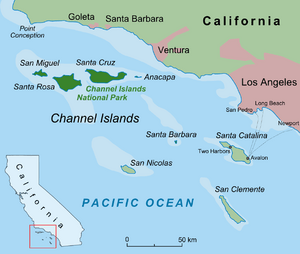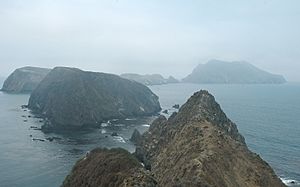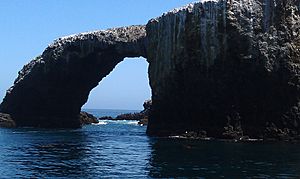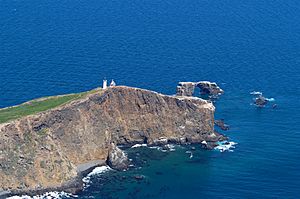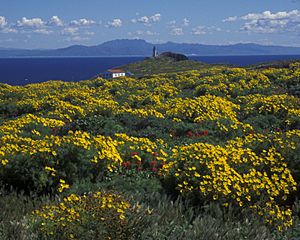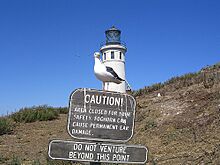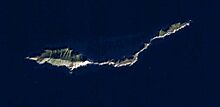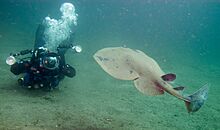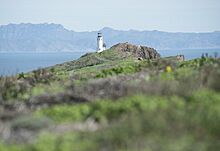Anacapa Island facts for kids
|
Native name:
Ennepah, 'Anyapakh
|
|
|---|---|

Satellite view of Anacapa Island
|
|
| Lua error in Module:Location_map at line 420: attempt to index field 'wikibase' (a nil value).
Anacapa Island
|
|
| Etymology | mirage island |
| Geography | |
| Location | Pacific Ocean |
| Archipelago | Northern Channel Islands |
| Adjacent bodies of water | Pacific Ocean |
| Major islands | West, Middle, East |
| Area | 699 acres (283 ha) |
| Length | 5 mi (8 km) |
| Width | 0.5 mi (0.8 km) |
| Highest elevation | 930 ft (283 m) |
| Highest point | Vela Peak/Summit Peak 2 |
| Administration | |
|
United States
|
|
| State | California |
| County | Ventura |
| Demographics | |
| Population | 3 (2000) |
| Additional information | |
| Official website | http://www.nps.gov/chis/planyourvisit/anacapa.htm |
Anacapa Island is a small volcanic island off the coast of Ventura County, California. Its name comes from the Chumash word Anyapax, which means "mirage" or "illusion."
The island is made up of three narrow parts called islets: East, Middle, and West Anacapa. These islets stretch about 6 miles (10 km) long. They have steep cliffs that drop sharply into the sea. Anacapa is the smallest of the northern Channel Islands. It is part of the Channel Islands National Park. The waters around its northern side are protected by the Anacapa State Marine Reserve.
Contents
How Anacapa Island Formed
Anacapa Island was created by volcanic eruptions between 19 and 15 million years ago. These eruptions happened because the Earth's plates were moving. The rocks on Anacapa are made of lava, volcanic ash, and other volcanic materials.
Over time, erosion from waves and wind shaped the island. This erosion caused Anacapa to split into the three islets we see today. You can find many cool rock formations like sea arches, sea caves, and stacks here.
West Anacapa is the biggest and highest islet, reaching about 930 feet (283 meters) tall. Middle Island is about 325 feet (99 meters) high, and East Island is about 250 feet (76 meters) at its highest point. All three islets together cover about 699 acres (2.8 sq km).
One of the most famous natural features is Arch Rock on East Island. It's a natural bridge about 40 feet (12 meters) high.
Thousands of years ago, when sea levels were much lower, Anacapa and the other northern Channel Islands were part of one big island called "Santa Rosae." Fossils of small pygmy mammoths have been found on the other islands, suggesting they might have lived on Anacapa too.
Amazing Wildlife and Plants
Anacapa Island is a very important home for many animals and plants. It's close to the busy coast of Southern California, but it's a safe haven for seabirds and pinnipeds like California sea lions. You might even spot Great white sharks in the waters around the island, as they hunt for sea lions.
The island has about 150 types of native plants. Sixteen of these plants are found only on the Channel Islands, and two are found only on Anacapa!
Birds of Anacapa
Anacapa is home to about 69 different bird species. The island's cliffs have many caves and cracks, which are perfect for nesting seabirds.
- The Scripps's murrelet is a threatened seabird that nests here.
- The ashy storm petrel also uses these cliffs.
- Anacapa has the largest breeding colony of California brown pelicans in the United States. Thanks to this safe place, their numbers have greatly increased since the 1970s.
- The islets also host the world's largest breeding colony of western gulls. These gulls start nesting in late April, and their fluffy chicks hatch in May and June.
Land Animals
The only native land mammal on Anacapa is a special type of deer mouse (Peromyscus maniculatus anacapae). This mouse lives on all three islets but nowhere else in the world!
Anacapa has two native reptiles:
- A unique type of Common side-blotched lizard (Uta stansburiana hesperis).
- The California alligator lizard (Elgaria multicarinata multicarinata).
There is also one amphibian, the Channel Islands slender salamander (Batrachoseps pacificus). The ocean around Anacapa is full of marine life too!
Island Plants
Anacapa used to be covered in a tall, showy plant called giant coreopsis (Leptosyne gigantea). This plant could grow up to 8 feet (2.4 meters) tall and had bright yellow flowers. It provided shelter for birds and food for the deer mice.
However, in the past, animals like sheep and rabbits were brought to the island. They ate many of the native plants, including the giant coreopsis. Building the lighthouse also caused some damage to the plant life.
A rare type of aster called Malacothrix junakii is found only on Anacapa. It's known from only two spots on the island.
Animals and Plants That Don't Belong
Over the years, some animals and plants were brought to Anacapa Island by people. These are called "introduced species" and they can harm the native wildlife.
- Black rats were a big problem. They attacked seabird nests and harmed other animals and plants. They likely arrived on ships carrying supplies.
- European rabbits were brought to East Island, possibly as food for lighthouse workers during World War II.
- Domestic cats were pets of a fisherman named "Frenchy," after whom Frenchy's Cove is named.
- Sheep were grazed on the island for many years, starting in the 1850s. They ate the native plants and compacted the soil.
- Two types of iceplant were planted by the U.S. Coast Guard. These plants spread quickly and took over native plant areas.
Helping the Island Recover
Great efforts have been made to help Anacapa Island's ecosystem recover.
- Sheep were removed around 1938, and rabbits in the 1950s.
- Black rats were successfully removed from the island by 2003. This was a big project that involved dropping special bait from the air. Before this, rats were attacking more than 96% of Scripps's Murrelet nests.
- After the rats were gone, the number of Scripps's Murrelet nests more than doubled! Another bird, the Cassin's auklet, even started nesting on Anacapa, even though it had never been seen nesting there before. This shows how important it was to remove the rats.
- The National Park Service is also working to remove the invasive iceplant.
Anacapa's Weather
Anacapa Island has a warm-summer Mediterranean climate. This means it has warm, dry summers and mild winters. The Pacific Ocean helps keep the temperatures from getting too extreme.
| Month | Jan | Feb | Mar | Apr | May | Jun | Jul | Aug | Sep | Oct | Nov | Dec | Year |
|---|---|---|---|---|---|---|---|---|---|---|---|---|---|
| Mean daily maximum °F (°C) | 62.1 (16.7) |
62.8 (17.1) |
64.5 (18.1) |
67.5 (19.7) |
70.1 (21.2) |
72.1 (22.3) |
74.3 (23.5) |
74.0 (23.3) |
73.5 (23.1) |
71.3 (21.8) |
64.8 (18.2) |
63.0 (17.2) |
68.5 (20.3) |
| Mean daily minimum °F (°C) | 50.8 (10.4) |
50.1 (10.1) |
50.7 (10.4) |
52.0 (11.1) |
54.7 (12.6) |
57.2 (14.0) |
59.2 (15.1) |
60.3 (15.7) |
60.1 (15.6) |
58.2 (14.6) |
52.2 (11.2) |
51.0 (10.6) |
54.9 (12.7) |
| Average precipitation inches (mm) | 5.36 (136) |
4.28 (109) |
3.10 (79) |
1.27 (32) |
0.46 (12) |
0.18 (4.6) |
0.15 (3.8) |
0.04 (1.0) |
0.23 (5.8) |
0.52 (13) |
1.53 (39) |
3.24 (82) |
20.36 (517) |
| Source: Western Regional Climate Center | |||||||||||||
A Look at Anacapa's Past
Anacapa is special because it's the only Channel Island without a Spanish name. Its name comes from the Chumash people, who were the first inhabitants.
In 1853, a steamboat called the SS Winfield Scott crashed into the rocks off Middle Anacapa and sank. Luckily, all the passengers survived and were rescued after a week.
Over the years, different people lived on or used the island:
- George Nidever was one of the first to raise sheep on the island in the mid-1800s.
- Later, a man named Ira Eaton used the island for his bootleg alcohol business during Prohibition in the United States.
- Raymond "Frenchy" LeDreau lived as a recluse on West Anacapa for 30 years. Frenchy's Cove is named after him.
The United States Lighthouse Service built a lighthouse on East Anacapa between 1930 and 1932. It was the last lighthouse built by the Lighthouse Service on the California coast. Lighthouse crews and their families lived on the island, sometimes as many as 15 to 25 people. In 1962, the lighthouse became automated, meaning it no longer needed people to operate it. Today, the United States Coast Guard still owns the property, but the National Park Service uses the old residences.
In 2000, a plane crash occurred near the island.
According to the 2000 census, only three people lived permanently on Anacapa Island, all at the ranger station on East Island.
Gallery
-
Pacific Electric Ray (torpedo californica) offshore of Anacapa
-
Looking toward mainland California across the Santa Barbara Channel
See also
 In Spanish: Isla Anacapa para niños
In Spanish: Isla Anacapa para niños


